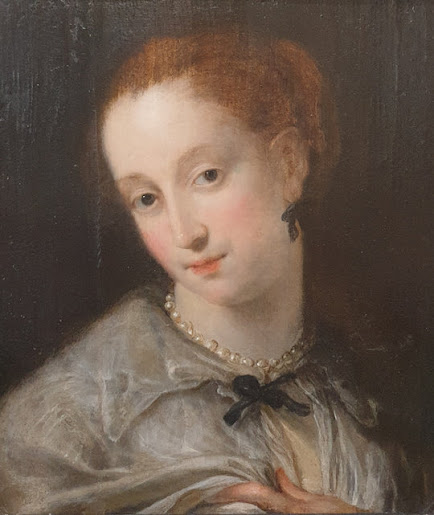The Intimate Language of Jewellery in Portraiture: Pearls and Coral
The Pearly Queen
Jewellery to this day remains a signifier of wealth and refinement, and has been considered an emblem of a sitter's extreme wealth in portraiture. In the famous Armada Portrait of Queen Elizabeth I, her extreme wealth is portrayed by the excess of opulent pearls in her costume: her dress is bejewelled, pearls circle her head, and the crown jewels glitter in the painting's background.
Given that natural pearls were incredibly rare and costly, the sheer amount of pearls present in the portrait are a clear indicator of her privelage. Their luminosity and associations with purity, femininity and godliness played an important part in fashioning the Virgin Queen that we see in portraiture.
Unknown English Artist (formerly attributed to George Gower), Armada Portrait, Oil on panel, 1588. Royal Museum Greenwich, The Queen's House.
Diana Singer noted that pearls 'in their ability to reflect light on the face' are the only gemstone that draw attention to the sitter rather than the precious stone. Pearl jewellery in portraiture can therefore not only reveal the sitter's status in society, or inward character, but act as an artistic device to draw our attention to the sitter themselves.
Vermeer, Girl with a Pearl Earring, oil painting, c. 1665. On display at The Mauritius.
Coral in Western Portraiture
Circle of Sir Thomas Lawrence English School. Portrait of a Young Lady Wearing Coral Beads, Oil on canvas, c. 1810. For sale at PBC Fine Art.
Coral throughout history has been believed to hold talismanic and apoptropaic powers. The ancient Romans would hang coral around their necks to ward off evil, injury and death - a tradition that was revived during the 19th century. Coral jewellery in the form of necklaces, bracelets and tiaras can be seen in portraits of the period.
Thomas Lawrence, Lady Maria Hamilton, Oil on canvas, c. 1804. On display at the Hunterian, University of Glasgow.
Children are frequently depicted wearing coral beads and amulets, a tragic realisation given that infant sickness and mortality was a common occurrence. As coral jewellery was frequently gifted to children in the hope that it would protect them from nightmares, illness and death, it is no surprise that we see so many portraits of children dressed with the red gemstone.
Early Victorian Portrait of a Child wearing Coral Beads, Oil painting, c. 1840. For sale at PBC Fine Art.
Jan Claez, Portrait of a Child With a Coral Necklace, Oil painting, c. 1636. The Bowes Museum.
Beyond the protective uses of coral, global trade was frequently expanding in the early modern period, and its appearance in portraiture is also revealing of how it became more widely accessible. Another possible interpretation of coral jewellery in portraits involved the Grand Tours across Europe, which saw an increased popularity in the 19th century. Reserved for aristocrats, the Grand Tour involved travelling across Europe to explore Greek and Roman antiquities, literature and art. Visits to Italy, where coral jewellery was readily available, may have lead travellers to purchase coral. Some art historians have therefore interpreted coral jewellery in portraiture to be a significant marker in how worldly or travelled the sitter is.
Adele Romany, Portrait of a Lady Standing Next to a Piano Forte Holding a Manuscript, Oil painting, c. 1808. Museum of Fine Arts Boston.
Discovering History at Grays Antique Market
Rare Row of Large Mediterranean Coral Beads, 19th century. For sale at Anthea AG Antiques.

.jpg)





.webp)






.jpg)
Comments
Post a Comment